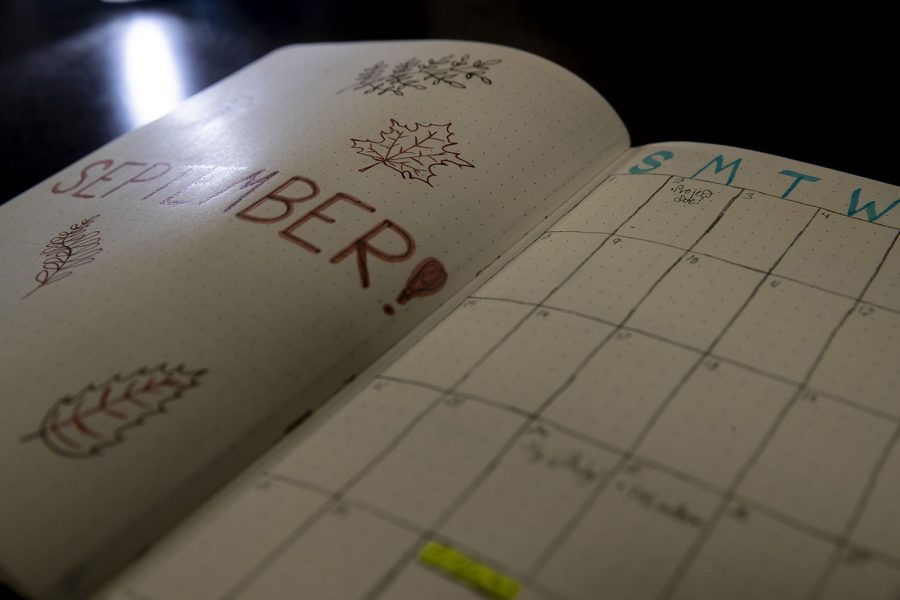Doodles, dots, and dashes: Inside the organized creativity of bullet journaling
A systematic form of journaling originated by a digital product designer in 2013, bullet journaling has become far more than a trendy way to schedule or plan.
Photo Illustration by Katie Goodale
August 28, 2019
Armed with pencils, a technicolor array of her beloved fine-point gel-pens, and a dozen or so patterned Post-It notes, University of Iowa sophomore Camryn Norton takes to the dotted pages of a small pink journal each morning.
Gliding the tip of her Tombow brush pen along the 1-millimeter paper to create detailed calligraphy lettering over a carefully drawn portrait of her weekly schedule, Norton is not simply creating artwork or preparing for the coming week when she journals — she is resting the qualms of her racing mind.
Like many organizational fanatics longing for a way to take their standard planners and notebooks to the next level, Norton has utilized the productive yet stress-relieving hobby of bullet journaling: a personalized, methodical system of journaling that digital designer and author Ryder Caroll created in 2013.
According to Caroll’s bullet journal website, “It’s best described as a mindfulness practice disguised as a productivity system. It’s designed to help you organize your ‘what’ while you remain aware of your ‘why’. The goal of the Bullet Journal is to help [bullet journalists] live intentional lives, ones that are productive and meaningful.”
In the years since its creation, images of the intricately designed dotted, or “bulleted” pages have crowded Pinterest, Instagram, and the blogs of organizational lifestyle influencers everywhere. Prices fluctuate from $7 for a best-selling dotted notebook on Amazon, to a nearly $30 hard-cover gridded journal on the shelves at Barnes & Noble. The price one is willing to pay is entirely up to the buyer, but supplies manager Kaylee Harney at Iowa Book believes any dotted notebook will do the trick.

University of Iowa student Camryn Norton is seen on Monday, August 26, 2019. Camryn is part of a group of students taking part in a new writing trend known as bullet journaling.
“They are very popular now, a lot of people like them. People could use any kind of journal but a lot of people like [bullet journals] because it gives them some sort of direction,” she said.
Harney said she sees most buyers fill the journals with colorful designs and schedules. However, the details of exactly how to mimic the style of the traditional bullet journal — nicknamed the “BuJo” by its followers, are difficult to define.
For a handful of UI student bullet journalists, this is because the limits of a “standard” bullet journal do not exist, and each journal is catered to the personal needs of its user. Journals can be filled with everything from habit trackers to grocery lists, bucket lists, vacation spots to visit, and bachelorette party-planning ideas.
For UI senior and Dance Marathon executive director Allie Stutting, her needs have toggled between administrative usage to emotional reassurance. Aside from tracking her sleep, water intake, and exercise for health purposes, Stutting used her journal to plan the entirety of the 2018 Iowa Rotary Youth Leadership Awards, an annual leadership conference with more than 250 student attendees that she said took the majority of the year to organize.
“Literally everything I did before I put it in a spreadsheet, I put it in my bullet journal,” she said. “When I was working on that conference, I used it every single day.”
In addition to meeting her organizational and lifestyle needs, Stutting also said writing and designing the pages in her bullet journal helped relieve the anxiety she felt while studying abroad in India over winter break.
“I was far away from home, I was on a different continent, I didn’t know anybody around me, I didn’t know the language,” she said. “So what I did is I took a Bible verse and I just opened up the back of my bullet journal and wrote down the verse and made it super beautiful. I’ll just have random pages with different sayings and stuff. It’s therapeutic.”
Now, Stutting uses a different style of journaling to plan different Dance Marathon events and all fundraising efforts leading up to the Big Event. She said having something to focus on in times of stress, while also being productive, has been calming and rewarding to look back on.
“It’s a good keepsake, and a very good way to go through the meticulous things that you did in the past,” she said. “A lot of times you don’t remember those things, but those are the things that make up who you are.”
For UI sophomore Emma Gostonczik, bullet journaling became a way to temporarily escape from her busy life — and the pain of her chronic tension headaches — when nothing else seemed to work.
“I tried acupuncture, massage therapy, physical therapy, yoga, and over-the-counter medication,” she said. “If you suffer from chronic pain, you’re probably never going to eliminate the issue entirely, but I used reading with low lighting and bullet journaling as stress-relief and that did help reduce my headaches when I was focused on one activity, but wasn’t straining my eyes or stressed.”
Aside from creating monthly schedules and doodling, Gostonczik uses her journal as a secure place to express her feelings when they become overwhelming.
“I tend to be a very open-book type of person, and while I realize it’s great to be open, it’s great to be honest with people, not everyone needs to know my life story,” she said. “I’ve found bullet journaling is something where I can express those feelings and put them in a secure place where they are out into the world but not necessarily being trusted with any people.”
Gostonczik said having somewhere to keep her thoughts safe has kept her from unneeded stress and kept her thoughts in order.
“I think a lot, I talk a lot, I overanalyze things,” she said. “When I can have those thoughts and accept them and put them on the paper, but not put myself in a vulnerable position by doing so, that really, really helped me emotionally. Everybody has mental struggles, and I think it’s so great to have an outlet that doesn’t put you in a negative position.”





